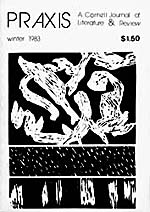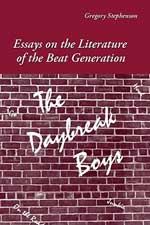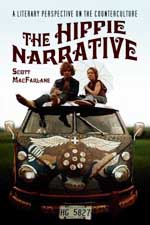Literary Criticism
Fariña's novel, Been Down So Long It Looks Like Up To Me, took a
beating from the critics when it first came out. Not
even the tragic death of the author could restrain the reviewers from
unleashing their contempt (although one relatively sympathetic critic, William
Hogan of the San Francisco Chronicle, admitted that he had written "a fairly
detailed negative review" which he felt compelled
to re-write after Fariña's death).
Been Down was often reviewed alongside Pynchon's The
Crying of Lot 49, which was published a few months later, and many critics
did not spare that novel either. Time magazine, reviewing both novels
together with Leonard Cohen's Beautiful Losers, dismissed all three
as "gibberish literature."
As the years passed, resistance to the counterculture faded
with familiarity as the counterculture slid into the mainstream. Many people
who were "on the scene" in the sixties were now on the faculty, and began to
try to make
sense of Fariña's strange novel. One early attempt was the Yale Review.
I've listed it in the criticism section instead of the review section because,
unlike most reviews, it sought to take the novel seriously, even though it
concluded with a judgement against it.
1.) Contemporary Reviews (unfavorable unless otherwise stated)
Been Down So Long It Looks Like Up To Me:
Kirkus Reviews, Feb 15, 1966, p. 209.
Publishers Weekly Feb 28, 1966, p. 90. J. Kitching.
Library Journal, Apr 1, 1966, p. 1924. Maybelle Lacey. (favorable)
Christian Science Monitor April 21, 1966. "The Uncloistered Campus," by
Melvin Maddocks.
San Francisco Chronicle, May 6, 1966. William Hogan:
"Richard Farina as a Novelist."
Time, May 6, 1966, p. 109. "Nosepicking Contests."
Saturday Review, May 28, 1966, p. 21. Granville Hicks: "A Season for
the Sensational."
New York Times, June 4, 1966, p. 27. Thomas Lask. (mixed)
Best Sellers (Scranton, PA), June 1, 1966, p. 87. Fred Rotondaro.
Los Angeles Times, June 26, 1966. Irwin Gold: "Echo of F. Scott Fitzgerald." (favorable)
Bookweek July 10, 1966, p. 8. "Making the Scene," by Richard Kluger.
Partisan Review , summer, 1966, p. 448. Stephen Donadio: "America, America."
National Review, Aug 9, 1966, p. 787. Guy Davenport: "The Strength of the Name."
New York Review of Books, Oct 6, 1966, p. 28. Bernard Bergonzi.
Kansas City Star, May 22, 1966. "Books in Brief," by Theodore M. O. Leary. (favorable)
Reviews of the Penguin Re-Issues:
New York Times Book Review, March 6, 1983, p. 39.
Washington Post, March 6, 1983, p. BW12. (favorable)
San Francisco Examiner, Review section, Sunday, April 17, 1983, p. 3.
Paired reviews by John Raskin (favorable) and Ellen Eagleson (negative).
"Why Read Richard Farina Now? To one critic, he was a 'mystical child', to
another, he was a burned out brute."
Creem, August, 1984. Fox Frank.
Times Literary Supplement, Sep 13, 1996, p. 25. Phil Baker:
"The Wrong Sixties."
Il Nuovo, April 3, 2002. Giancarlo De Cataldo: "L'anticonformismo 'cool' di Farinha." (favorable)
Long Time Coming and a Long Time Gone:
Baltimore Sun August 3, 1969. "Rebel Genius Cut Down Too Soon," by
Barbara Rowes. (favorable)
Booklist v. 66, Sep 15, 1969.
Kirkus v. 37, Mar 1, 1969; Apr. 1, 1969.
Library Journal v. 94, June 1, Sep 15, Dec 15, 1969.
Nation v. 209, Jul 28, 1969. p. 90. Sara Blackburn.
Publishers Weekly v. 195, Feb 24, 1969.
San Francisco Chronicle June 13, 1969. "A Celebration of the Living
Moment," by Michael Grieg. (favorable)
Saturday Review vol. 52, July 5, 1969, p. 36, 50.
"Rock-Folk-Protest Scene," by Henry S. Resnik. (favorable)
Wall Street Journal v. 174, Jul 22, 1969. "Young Romantic," by Ronald
Martinetti.
Los Angeles Free Press November 7, 1969.
p. 34 & 42. "Amazing Exciting Unique..." Robert Meyers. (favorable)
[This article reviews both Long Time and Been Down So Long together.]
Los Angeles Times Apr 25, 1971, p. U19. "Farina Essay, Poetry, Stories
on Baez, Dylan," by William S. Murphy. (favorable)
2.) Literary Criticism
Trachtenberg, Stanley. "Beyond Initiation: Some Recent Novels."
Yale Review, vol. 56, Autumn, 1966, p. 131-138.
Discusses Been Down So Long with The Crying of Lot 49, The Saddest
Summer of Samuel S., by J. P. Donleavy, A Generous Man, by Reynolds
Price, and The Last Gentleman, by Walker Percy. Traces the evolution
of the Initiate in literature from the "transcendent truths" of Greek tragedy
to the black humor of contemporary fiction. The Initiate once passed from
innocence to experience with a morality modified by confrontation and reconciliation
with
society. In the 19th century, the Initiate began to resist reconciliation and
retreated into childhood. The current existential hero is dispossessed
from reality and bereft of values. The character of Gnossos relies
upon "a set of assumptions outside the novel" and fails
to "acknowledge the source of his sense of betrayal." Gnossos does
not understand "where he is really at" and is therefore unaware of his
responsibilities.
Richard Lehan. "The American Novel--A Survey of 1966."
Wisconsin Studies in Contemporary Literature, vol 8, Summer 1967, p. 437-49.
Lehan identifies several thematic trends in recent fiction: unheroic heroes,
Romantic wanderers who take to the road in quest of one all-encompassing
experience that will both illuminate the mind and satisfy the soul, escape from
the ennui of modern man diversted of hope, all of which he summarizes under the
heading of "homelessness." He dismisses Fariña's and Pynchon's novels briefly in
the concluding paragraphs:
Thomas Pynchon's The Crying of Lot 49 and Richard Fariña's Been Down So
Long It Looks Like Up To Me are not successful novels--not because their
characters are beat and rootless--but because they are motiveless. In [other novels
reviewed in the survey], we see characters caught between two worlds--we see them in
contrast to the societies they either accept or reject. In Pynchon's and Fariña's
novels, however, we move into an isolated solipsistic world. Such a world must be
its own justification because all we have is an inarticulate hero to justify it.
These novels demand more narratively than Pynchon or Fariña supply. Since the novels
of 1966 are, in the main, obsessed with homeless people, it is not surprising that
their great narrative achievement is often a scene dealing with the moment or moments
of rejection. Pynchon and Fariña begin beyond this point, take the rejection for
granted, see erratic behavior as an end in itself, and are content to remain within
the hole in time. Their novels might be more accomplished if they themselves were
aware that what is going on within this hole in time is a modern dance of death.
Lyons, John O. "The College Novel in America: 1962-1974."
Critique vol. 16, no. 2, 1974. Pages 121-128.
This addendum to the author's 1962 survey, The College Novel in America, briefly
reviews more recent college novels. He notes that Been Down "continues the
iconoclastic Cornell Bildungsroman of the fifties by Clifford Irving, On
a Darkling Plain (1956), Charles Thompson, Halfway Down the Stairs (1957),
and Robert Gutwillig, After Long Silence (1958). The oscillation between
weltschmertz and pranks in these novels was undoubtedly an influence on "The
Whole Sick Crew" of Pynchon's V."
Bluestein, Gene. "Laughin' Just to Keep from Cryin': Fariña's Blues Novel."
Journal of Popular Culture 9, (1976): Pages 926-34.
Places Been Down So Long in the context of "literary
Calvinism," by pessimism, determinism, and visions of
apocalypse. Literary Calvinism begins with Melville and culminates in Fariña's
age with such contemporaries as Pynchon, Brautigan, and Vonnegut. Also
compares Fariña's pop-culture allusions to Twain's use of
folk motifs.
Hill, Hamlin. "Black Humor and the Mass Audience."
American Humor: Essays Presented to
John C. Gerber, edited by O.M. Brack. Scottsdale, AZ: Arete, 1977. 193 pages.
In the introduction to this volume of essays, Hill classes Been Down So Long
with Myra Breckenridge and Portnoy's Complaint as symptoms of
a new wave of black humor that lacks sophistication and is "comfortably
undemanding." The author speculates in passing that an allusion to Phidias (the Greek
sculptor) or Michelangelo would be unthinkable in the novel. Hill has apparently forgotten
that Gnossos quotes a poem of Michelangelo and that classical allusions are
frequent in the novel.
Contemporary Literary Criticism,
Volume 9. Gale, 1978. Pages 195-197.
A collection of excerpts from various reviews of Been Down So Long It
Looks Like Up To Me, as well as excerpts from the Bluestein article.
Although this has only excerpts from other sources rather than original material,
I include it here since the Contemporary Literary Criticism volumes
are easily available in most large libraries, and the original essays may
be more difficult to obtain.
Cowart, David. Thomas Pynchon: The Art of the Allusion.
Carbondale: Southern Illinois University Press, 1982.
Identifies Fariña as a "kindred spirit" to Pynchon. He suggests Slothrup's
dream of The White Rabbit in Gravity's Rainbow (page 468) may symbolize
Fariña, who played the voice of The White Rabbit in the Tale Spinners for
Children recording of Alice in Wonderland. He also suggests that
Fariña's Heffalump may represent Pynchon, as Gnossos and Heffalump engage in a
trivia contest involving Fariña's and Pynchon's common pop-culture interests
in Hop Harrigan and Tank Tinker (who are also mentioned in Pynchon's novels).
Some other similarities:
There were obviously many shared enthusiasms and paranoias, and much intellectual
cross-fertilization. Sometimes they even wrote the same way. Though Pynchon has
the wider stylisitic repertoire, both tend to favor fast-moving prose that often
defies conventional grammar, depending on participial phrases that ought to "dangle,"
but somehow propel instead. Their works are equally studded with catalogues,
equations (both had abandoned engineering programs), and parodies of the Mass, not
to mention references to movies, the harmonica, the color magenta, aqua regia,
black and Latin culture, comics, radio serials, and Vivaldi.... In jazz, they
shared a contempt for Dave Brubeck, and a liking for Ornette Coleman.... Both
delight in comic voices. The Nazi officers, pachucos, Transylvanians, blacks,
comic Englishmen, and radio characters like Lamont Cranston who stalk through
Pynchon's fiction may have been inspired by Fariña's repertoire of such voices,
which his sister-in-law, Joan Baez, describes in her introduction to the Long
Time Coming collection. Both loved comedy, and both were fascinated by death.
Though Fariña was often, in his wife's term, very "deathy," he did not live long
enough for his youthful, Hamlet-like brooding on mortality to mature into real
nihilism. Perhaps in time, like his friend, he would have tempered nihilism with
something like mysticism and discovered in fantasy and in the heartening vistas
of the imagination that physics is metaphor, not law.
Seed, David. "Richard Fariña's Protest Novel."
Journal of American Culture vol. 5, no. 2. Summer 1982. p. 104-114.
This is probably the single best essay on Fariña's novel. Its interpretations are
compatible with those of Bluestein (above) and Stephenson (below), but with a greater emphasis on
the irony, leaving little room for doubt that Fariña knew what he was doing and
did not intend Gnossos to be an admirable character. But Seed is also realistic
about Fariña's achievement: "Clearly a novel of this kind is prepared to take risks and
not all the gambles will pay off," and he goes on list some of the novels faults.
A clearly written and well-balanced assessment of the novel, with several keen
observations I've not seen elsewhere, and responses to some of the critics.
 Tabbi, Joseph: "INSIDE and OUTSIDE: A Fariña Perspective."
Tabbi, Joseph: "INSIDE and OUTSIDE: A Fariña Perspective."
Praxis: A Cornell Journal of Literature & Review.
vol. 8, no. 2, Winter 1983. p. 51-53, 65.
A short and tentative but thoughtful article showing how Fariña critiqued the beatnik stance of
non-involvement in his novel and in the short story "God Bless America and All the
Ships at Sea." This is one of the few attempts I've seen to compare Fariña's novel
with his other writings in order to outline his overall themes and artistic aims.
Pynchon, Thomas, "Introduction."
Been Down So Long It Looks Like Up To Me.
New York: Penguin, 1983.
Pynchon's affectionate tribute to his old friend, written
as an introduction for the 1983 reprint, includes valuable insights into
Fariña the man and the artist. This essay was reprinted in Cornell Alumni News,
June 1984.
Full text.
Seed, David, The Fictional Labyrinths of Thomas Pynchon.
Iowa City:
University of Iowa Press, 1988.
Observes several similarities in the styles and themes of Pynchon and Fariña,
including: an interest in the Beat lifestyle (which he also traces back to Helen
Waddell's study of medieval minstrels, The Wandering Scholars), a critique
of consumerism through references to pop-culture, the use of mock-picaresque
chapter headings to "comically distance the reader from the absurd sequence of
events," and two Pynchon characters that resemble Gnossos: Nathan "Lardass" Levine
(from the short story "Small Rain") and Slothrop (from Gravity's Rainbow),
who struggle for Exemption and non-commitment by trying on a variety of roles.
 Stephenson, Gregory, The Daybreak Boys: Essays on the Literature of the Beat
Generation.
Stephenson, Gregory, The Daybreak Boys: Essays on the Literature of the Beat
Generation.
Carbondale and
Edwardsville: Southern Illinois University Press, 1990.
This book includes a chapter called "Toward Organized
Innocence: Richard Fariña's Been Down So Long It
Looks Like Up To Me" (pages 131-138). A useful discussion of the many
themes and symbols in the novel, and one of the few books on the Beats to
acknowledge Fariña's involvement.
McCarron, William. "Fariña and Pynchon."
Notes on Contemporary Literature
22, no. 4 (1992 Sept). Pages 11-12.
Briefly summarizes the thematic similarities between Fariña
and Pynchon observed in two recent books, David Cowart's Thomas Pynchon:
The Art of Allusion, and David Seed's The Fictional Labyrinth of Thomas
Pynchon.
Whissen, Thomas R. Classic Cult Fiction: A Companion to Popular Cult Literature.
New York: Greenwod Press, 1992.
Brief discussions of novels that have attained "cult" status, including novels by
Brautigan, Pirsig,
Kesey, Kerouac, Fitzgerald, Hemingway, and Huxley. The discussion
of Been Down So Long (on pages 25-29) was not particularly illuminating.
Beidler, Philip D. Scriptures for a Generation: What We Were Reading in the '60s.
Athens: University of Georgia Press, 1994.
This survey of authors that were popular in the sixties--including not just
contemporaries but also classic authors that enjoyed a revival, such as Hesse and
Thoreau--has a section on Fariña on pages 67-71. Beidler praises Fariña's "immense
original energy: the bizarre erudition, the queer verbal fecundity, the mockings
and invocations piling all over each other in manic plenitude." However, he
criticizes Fariña for being too derivative of Kerouac, Kesey, Heller, Pynchon and
Donleavy, and he observes,
as so many others have, that the book has not aged well: "Once it seemed a truly
original portrait of the artist as campus iconoclast and madman-saint...[but]...
much of the business now increasingly strikes us as minor '60s collage....The
artist-iconoclast would shortly come to be seen as the latest case of arrested
development, the prodigy of the revolution as a campus clod."
Cooke, Douglas. "Pursuit of the Real--and escape from Reality." 2001.
Discusses the tension between Gnossos' illusion of exemption and his
sublimated death-wish.
Full text.
Davis, Robert Murray. "Whatever Happened to Richard Farina?"
World Literature Today,
May - June 2006. P. 39-41.
Discusses Gnossos' regressive personality in relation to similar tendencies in late 50s
culture, finding Fariña's novel less genuinely rebelious than Catcher in the Rye
and On the Road, and less artistic than The Crying of Lot 49. Davis points
out that 1958 was not a bad year to get drafted, and a lot better than prosecution for
heroin possession.
McFarlane, Scott. The hippie narrative : a literary perspective on the counterculture.
Jefferson, N.C.: McFarland & Co, 2007.
A survey of counterculture literature from 1962 to 1976. In the chapter "Been Down So Long
It Looks Like Up To Me and The Crying of Lot 49 (1966): A Chic Cabal," McFarlane concludes
that Fariña "did not create a palpable sense of the motive or dysfunction driving Gnossos's
circumstance. The reader was left trying to keep up with a character who is animated, but
for whom we are not given a tangible sense of ordeal or mission."
|

|
Ryan Pepper: "It's Lit in the Library."
thefulcrum.ca, September 10, 2017.
http://thefulcrum.ca/arts/lit-library-long-looks-like-richard-farina/
A brief and somewhat ill-informed appreciation published on a Canadian news site.
3.) Honorable mention:
Been Down So Long It Looks Like Up To Me has been included on several
"required reading" lists of sixties books:
- Gene Sculatti: The Catalog of Cool. New York: Warner Books, 1982.
- Alan Bisbort and Parke Puterbaugh: Rhino's Psychedelic Trip. Miller Freeman Books, 2000.
- Michael Dirda: "Books That Helped Make the Age of Aquarius." Washington
Post, July 29, 1989.
Full text.
- Paul Williams: The Twentieth Century's Greatest Hits. Fariña's novel
didn't make the list, but it is mentioned in the entry on Winnie the
Pooh as "A fabulous novel, by the way, worth seeking out." (Williams had
published an essay of Fariña's in his classic rock magazine, Crawdaddy.)
- It was also on Jim Morrison's list of favorite books, according to several
biographers.
Finally, Long Time Coming and a Long Time Gone was listed in Outstanding Books
for the College Bound: Choices for a Generation, edited by Marjorie Lewis.
Home
 Tabbi, Joseph: "INSIDE and OUTSIDE: A Fariña Perspective."
Tabbi, Joseph: "INSIDE and OUTSIDE: A Fariña Perspective."  Stephenson, Gregory, The Daybreak Boys: Essays on the Literature of the Beat
Generation.
Stephenson, Gregory, The Daybreak Boys: Essays on the Literature of the Beat
Generation.